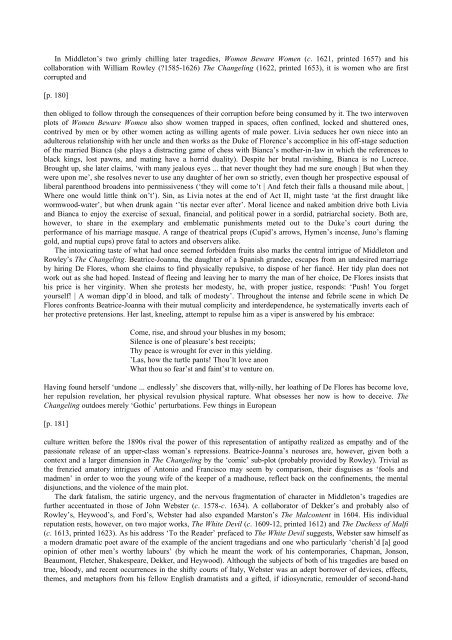THE SHORT OXFORD HISTORY OF ENGLISH LITERATURE
THE SHORT OXFORD HISTORY OF ENGLISH LITERATURE
THE SHORT OXFORD HISTORY OF ENGLISH LITERATURE
You also want an ePaper? Increase the reach of your titles
YUMPU automatically turns print PDFs into web optimized ePapers that Google loves.
In Middleton’s two grimly chilling later tragedies, Women Beware Women (c. 1621, printed 1657) and his<br />
collaboration with William Rowley (?1585-1626) The Changeling (1622, printed 1653), it is women who are first<br />
corrupted and<br />
[p. 180]<br />
then obliged to follow through the consequences of their corruption before being consumed by it. The two interwoven<br />
plots of Women Beware Women also show women trapped in spaces, often confined, locked and shuttered ones,<br />
contrived by men or by other women acting as willing agents of male power. Livia seduces her own niece into an<br />
adulterous relationship with her uncle and then works as the Duke of Florence’s accomplice in his off-stage seduction<br />
of the married Bianca (she plays a distracting game of chess with Bianca’s mother-in-law in which the references to<br />
black kings, lost pawns, and mating have a horrid duality). Despite her brutal ravishing, Bianca is no Lucrece.<br />
Brought up, she later claims, ‘with many jealous eyes ... that never thought they had me sure enough | But when they<br />
were upon me’, she resolves never to use any daughter of her own so strictly, even though her prospective espousal of<br />
liberal parenthood broadens into permissiveness (‘they will come to’t | And fetch their falls a thousand mile about, |<br />
Where one would little think on’t’). Sin, as Livia notes at the end of Act II, might taste ‘at the first draught like<br />
wormwood-water’, but when drunk again ‘’tis nectar ever after’. Moral licence and naked ambition drive both Livia<br />
and Bianca to enjoy the exercise of sexual, financial, and political power in a sordid, patriarchal society. Both are,<br />
however, to share in the exemplary and emblematic punishments meted out to the Duke’s court during the<br />
performance of his marriage masque. A range of theatrical props (Cupid’s arrows, Hymen’s incense, Juno’s flaming<br />
gold, and nuptial cups) prove fatal to actors and observers alike.<br />
The intoxicating taste of what had once seemed forbidden fruits also marks the central intrigue of Middleton and<br />
Rowley’s The Changeling. Beatrice-Joanna, the daughter of a Spanish grandee, escapes from an undesired marriage<br />
by hiring De Flores, whom she claims to find physically repulsive, to dispose of her fiancé. Her tidy plan does not<br />
work out as she had hoped. Instead of fleeing and leaving her to marry the man of her choice, De Flores insists that<br />
his price is her virginity. When she protests her modesty, he, with proper justice, responds: ‘Push! You forget<br />
yourself! | A woman dipp’d in blood, and talk of modesty’. Throughout the intense and febrile scene in which De<br />
Flores confronts Beatrice-Joanna with their mutual complicity and interdependence, he systematically inverts each of<br />
her protective pretensions. Her last, kneeling, attempt to repulse him as a viper is answered by his embrace:<br />
Come, rise, and shroud your blushes in my bosom;<br />
Silence is one of pleasure’s best receipts;<br />
Thy peace is wrought for ever in this yielding.<br />
’Las, how the turtle pants! Thou’lt love anon<br />
What thou so fear’st and faint’st to venture on.<br />
Having found herself ‘undone ... endlessly’ she discovers that, willy-nilly, her loathing of De Flores has become love,<br />
her repulsion revelation, her physical revulsion physical rapture. What obsesses her now is how to deceive. The<br />
Changeling outdoes merely ‘Gothic’ perturbations. Few things in European<br />
[p. 181]<br />
culture written before the 1890s rival the power of this representation of antipathy realized as empathy and of the<br />
passionate release of an upper-class woman’s repressions. Beatrice-Joanna’s neuroses are, however, given both a<br />
context and a larger dimension in The Changeling by the ‘comic’ sub-plot (probably provided by Rowley). Trivial as<br />
the frenzied amatory intrigues of Antonio and Francisco may seem by comparison, their disguises as ‘fools and<br />
madmen’ in order to woo the young wife of the keeper of a madhouse, reflect back on the confinements, the mental<br />
disjunctions, and the violence of the main plot.<br />
The dark fatalism, the satiric urgency, and the nervous fragmentation of character in Middleton’s tragedies are<br />
further accentuated in those of John Webster (c. 1578-c. 1634). A collaborator of Dekker’s and probably also of<br />
Rowley’s, Heywood’s, and Ford’s, Webster had also expanded Marston’s The Malcontent in 1604. His individual<br />
reputation rests, however, on two major works, The White Devil (c. 1609-12, printed 1612) and The Duchess of Malfi<br />
(c. 1613, printed 1623). As his address ‘To the Reader’ prefaced to The White Devil suggests, Webster saw himself as<br />
a modern dramatic poet aware of the example of the ancient tragedians and one who particularly ‘cherish’d [a] good<br />
opinion of other men’s worthy labours’ (by which he meant the work of his contemporaries, Chapman, Jonson,<br />
Beaumont, Fletcher, Shakespeare, Dekker, and Heywood). Although the subjects of both of his tragedies are based on<br />
true, bloody, and recent occurrences in the shifty courts of Italy, Webster was an adept borrower of devices, effects,<br />
themes, and metaphors from his fellow English dramatists and a gifted, if idiosyncratic, remoulder of second-hand









